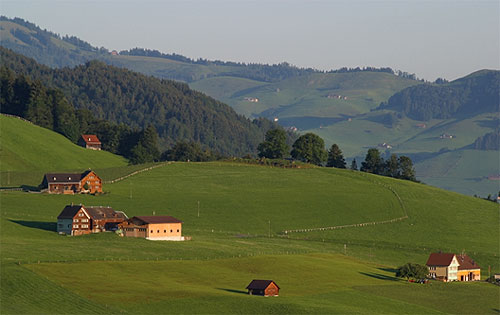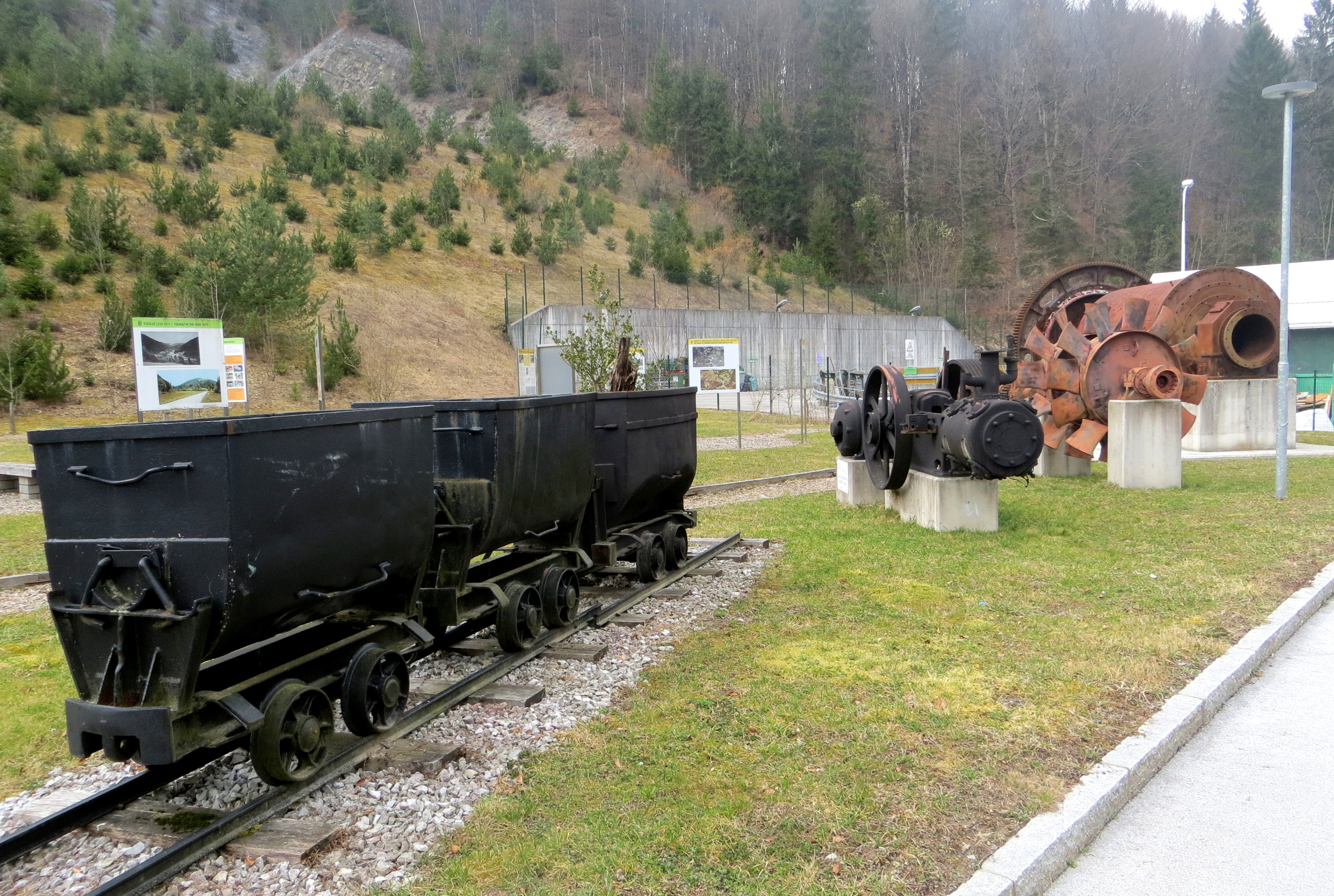|
é§irovski Vrh Svetega Urbana
é§irovski Vrh Svetega Urbana () is a dispersed settlement above Todraéƒ in the Municipality of Gorenja VasãPoljane in the Upper Carniola region of Slovenia. Name The name of the settlement was changed from ''é§irovski Vrh Svetega Urbana'' (literally, 'é§iri Peak of Saint Urban') to ''é§irovski Vrh nad Zalo'' (literally, 'é§iri Peak above Zala') in 1955. The name was changed on the basis of the 1948 Law on Names of Settlements and Designations of Squares, Streets, and Buildings as part of efforts by Slovenia's postwar communist government to remove religious elements from toponyms. The name ''é§irovski Vrh Svetega Urbana'' was restored in 1994. History The Rupnik Line, a line of fortifications and weapons installations, was built in the area in the 1930s. Several Pillbox (military), pillboxes from the line are preserved in the village's territory. Industry In the northeastern part of the settlement, there is a site where the tailings from the nearby Uranium mining, uranium mine ... [...More Info...] [...Related Items...] OR: [Wikipedia] [Google] [Baidu] |
Flag Of Slovenia
The national flag of Slovenia () features three equal horizontal bands of white (top), blue, and red, with the coat of arms of Slovenia located in the upper hoist side of the flag centred in the white and blue bands. The coat of arms is a shield with the image of Mount Triglav, Slovenia's highest peak, in white against a blue background at the centre; beneath it are two wavy blue lines representing the Adriatic Sea and local rivers, and above it are three six-pointed golden stars arranged in an inverted triangle which are taken from the coat of arms of the Counts of Celje, the great Slovene dynastic house of the late 14th and early 15th centuries. The Slovenian flag's colours are considered to be Pan-Slavism, pan-Slavic, but they actually come from the Middle Ages, medieval coat of arms of the Holy Roman duchy of Carniola, consisting of 3 stars, a mountain, and three colours (red, blue, yellow), crescent. The existing Slovene tricolor, Slovene tricolour was raised for the first t ... [...More Info...] [...Related Items...] OR: [Wikipedia] [Google] [Baidu] |
Slovenia
Slovenia, officially the Republic of Slovenia, is a country in Central Europe. It borders Italy to the west, Austria to the north, Hungary to the northeast, Croatia to the south and southeast, and a short (46.6 km) coastline within the Adriatic Sea to the southwest, which is part of the Mediterranean Sea. Slovenia is mostly mountainous and forested, covers , and has a population of approximately 2.1 million people. Slovene language, Slovene is the official language. Slovenia has a predominantly temperate continental climate, with the exception of the Slovene Littoral and the Julian Alps. Ljubljana, the capital and List of cities and towns in Slovenia, largest city of Slovenia, is geographically situated near the centre of the country. Other larger urban centers are Maribor, Ptuj, Kranj, Celje, and Koper. Slovenia's territory has been part of many different states: the Byzantine Empire, the Carolingian Empire, the Holy Roman Empire, the Kingdom of Hungary, the Republic of Venice ... [...More Info...] [...Related Items...] OR: [Wikipedia] [Google] [Baidu] |
Upper Carniola
Upper Carniola ( ; ; ) is a traditional region of Slovenia, the northern mountainous part of the larger Carniola region. The largest town in the region is Kranj, and other urban centers include Kamnik, Jesenice, Jesenice, Jesenice, Doméƒale and é kofja Loka. It has around 300,000 inhabitants or 14% of the population of Slovenia. Historical background Its origins as a separate political entity can be traced back to the 17th century, when the Habsburg monarchy, Habsburg duchy of Duchy of Carniola, Carniola was divided into three administrative districts. This division was thoroughly described by the scholar Johann Weikhard von Valvasor in his 1689 work ''The Glory of the Duchy of Carniola''. The districts were known in German as (; ''kresija'' in old Slovene). They were: ''Upper Carniola'' with its administrative seat in Ljubljana, comprising the northern areas of the duchy; ''Lower Carniola'', comprising the east and south-east, with its administrative seat in Novo Mesto; an ... [...More Info...] [...Related Items...] OR: [Wikipedia] [Google] [Baidu] |
Statistical Regions Of Slovenia
The statistical regions of Slovenia are 12 administrative entities created in 2000 for legal and statistical purposes. Division By a decree in 2000, Slovenia has been divided into 12 statistical regions (Nomenclature of Territorial Units for Statistics, NUTS-3 level), which are grouped in two cohesion regions (NUTS-2 level). The statistical regions have been grouped into two cohesion regions are: *Eastern Slovenia (''Vzhodna Slovenija'' ã SI01), which groups the Mura, Drava, Carinthia, Savinja, Central Sava, Lower Sava, Southeast Slovenia, and LittoralãInner Carniola regions. *Western Slovenia (''Zahodna Slovenija'' ã SI02), which groups the Central Slovenia, Upper Carniola, Gorizia, and CoastalãKarst regions. Sources Slovenian regions in figures 2014 See also *List of Slovenian regions by Human Development Index *Municipalities of Slovenia *Traditional regions of Slovenia References External links Regions Stat.si (accessed 15 December 2020). Map of st ... [...More Info...] [...Related Items...] OR: [Wikipedia] [Google] [Baidu] |
Upper Carniola Statistical Region
The Upper Carniola Statistical Region () is a Statistical regions of Slovenia, statistical region in northwest Slovenia. It is a region with high mountains, including Mount Triglav, and is almost entirely Alpine. A large part of this statistical region is protected as a national park. The relief and climate are good bases for tourism. In 2013, the region recorded almost 19% of tourist nights in Slovenia, of which 78% were by foreign tourists. The region ranked second in Slovenia in number of tourist beds per 1,000 population, even though it had just over half as many beds as the CoastalãKarst Statistical Region. In 2013, the registered unemployment rate here was the lowest in Slovenia, 3 percentage points lower than the national average and more than 8 percentage points lower than in the Mura Statistical Region, where the registered unemployment rate was the highest. Although agriculture in this region is not among the most important activities, the farms are among the largest in ... [...More Info...] [...Related Items...] OR: [Wikipedia] [Google] [Baidu] |
Municipalities Of Slovenia
Slovenia is divided into 212 municipalities (Slovene language, Slovene: ''obáine'', singular''obáina''), of which 12 have urban (metropolitan) status. Municipalities are further divided into local communities and districts. Slovenia has the largest number of first-level administrative divisions of any country. The municipalities vary considerably in size and population, from the capital Ljubljana with more than 280,000 inhabitants to HodoéÀ with fewer than 400. Urban status is not granted strictly on the basis of population; the smallest urban municipality, Urban Municipality of Slovenj Gradec, Slovenj Gradec, has less than half as many inhabitants as the most populous non-urban municipality, Municipality of Doméƒale, Doméƒale. Slovene language, Slovene is the official language in all municipalities. Hungarian language, Hungarian is the second official language of three municipalities in Prekmurje: Dobrovnik/Dobronak, HodoéÀ/Hodos, and Lendava/Lendva. Italian language, Italian ... [...More Info...] [...Related Items...] OR: [Wikipedia] [Google] [Baidu] |
Municipality Of Gorenja VasãPoljane
The Municipality of Gorenja VasãPoljane (; ) is a municipality in Slovenia. Its administrative seat is Gorenja Vas. Settlements In addition to the municipal seat of Gorenja Vas, the municipality also includes the following settlements: * Baáne * Brebovnica * Bukov Vrh * áabraáe * áetena Ravan * Debeni * Delnice * Dobje * DobravéÀce * Dolenáice * Dolenja Dobrava * Dolenja Ravan * Dolenja é§etina * Dolenje Brdo * Dolge Njive * Fuéƒine * Goli Vrh * Gorenja Dobrava * Gorenja Ravan * Gorenja é§etina * Gorenje Brdo * Hlaváe Njive * HobovéÀe pri Stari Oselici * Hotavlje * Hotovlja * Jaráje Brdo * Javorje * Javorjev Dol * Jazbine * Jelovica * Kladje * Kopaánica * Kremenik * Krivo Brdo * Krnice pri Novakih * LajéÀe * LaniéÀe * Laze * Leskovica * Lom nad Voláo * Lovsko Brdo * Luáine * Malenski Vrh * Mlaka nad LuéÀo * Murave * Nova Oselica * Podgora * Podjelovo Brdo * Podobeno * Podvrh * Poljane nad é kofjo Loko * Predmost * Prele ... [...More Info...] [...Related Items...] OR: [Wikipedia] [Google] [Baidu] |
Dispersed Settlement
A dispersed settlement, also known as a scattered settlement, is one of the main types of settlement patterns used by landscape historians to classify rural settlements found in England and other parts of the world. Typically, there are a number of separate farmsteads scattered throughout the area. A dispersed settlement contrasts with a nucleated village. The French term '' bocage'' is sometimes used to describe the type of landscape found where dispersed settlements are common. In addition to Western Europe, dispersed patterns of settlement are found in parts of Papua New Guinea, as among the Gainj, Ankave, and Baining tribes. It is also frequently met with in nomadic pastoral societies. In Ghana, Kumbyili in the northern region is also an example of a dispersed settlement England In England, dispersed settlements are often found in the areas of ancient enclosure outside the central regionãfor example, Essex, Kent and the West Country. An example of a dispersed settlemen ... [...More Info...] [...Related Items...] OR: [Wikipedia] [Google] [Baidu] |
Todraéƒ
Todraéƒ () is a small settlement southeast of Gorenja Vas, Gorenja VasãPoljane, Gorenja Vas in the Municipality of Gorenja VasãPoljane in the Upper Carniola region of Slovenia. Name The name Todraéƒ was first attested in written sources as ''Witodras'' in 1291 and 1381 (and ''Wittodrasy'' in 1501). These transcriptions indicate that it is derived from ''*Vitodraéƒ'', in turn based on the Slavic personal name ''Vitodrag''. Uranium mine The headquarters of the é§irovski Vrh Uranium mining, Uranium Mine are in the settlement. The mine was permanently closed in the 1990s and the site has been cleaned up by the company in charge of closing the mine, Rudnik é§irovski Vrh, based in Todraéƒ. References Exter ...
|
Rupnik Line
The Rupnik Line (), was a line of World War IIãera fortifications and weapons installations that Yugoslavia constructed along its terrestrial western and northern border. The construction of the line, named after General Leon Rupnik, was a safety measure taken in order to counter the construction of the Italian Alpine Wall, a line built by the bordering country Italy, as well as against the imposing danger of a German invasion following the ''Anschluss'' of Austria. Yugoslavia's Rupnik Line was inspired by various other fortification systems built along borders, mainly by France, Czechoslovakia and neighboring Italy. It was established to provide good positions to enforce the existing border, as well as to repel a potential invasion. Although there were around 15,000 troops manning the fortifications at its peak, with a potential of housing a total of 40,000, the line was never used to full potential, as it was largely unprepared and abandoned by the time Yugoslavia was invad ... [...More Info...] [...Related Items...] OR: [Wikipedia] [Google] [Baidu] |
Pillbox (military)
A pillbox is a type of blockhouse, or concrete dug-in guard-post, often camouflaged, normally equipped with Loophole_(firearm), loopholes through which defenders can fire weapons. It is in effect a trench warfare , trench firing step, hardened to protect against small-arms fire and grenades, and raised to improve the field of fire. The modern concrete pillbox originated on the Western Front (World War I) , Western Front of World War I, in the Imperial German Army , German Army in 1916. Etymology The origin of the term is disputed. It has been widely assumed to be a jocular reference to the perceived similarity of the fortifications to the Cylinder, cylindrical and hexagonal boxes in which medical pills were once sold; also, the first German concrete pillboxes discovered by the Allies in Belgium were so small and light that they were easily tilted or turned upside down by the nearby explosion of even medium (240mm) shells. However, it seems more likely that it original ... [...More Info...] [...Related Items...] OR: [Wikipedia] [Google] [Baidu] |






